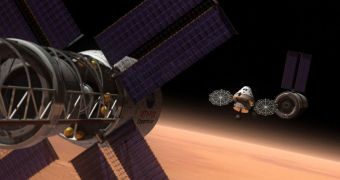On Tuesday, May 24, the American space agency made an important announcement, that has considerable implications for the future of space exploration. NASA officials said in a teleconference that the next major spacecraft the agency will operate is the Multi-Purpose Crew Vehicle (MPCV).
This vehicle is based on concepts of the Orion Crew Exploration Vehicle, as it appeared in Project Constellation. The latter was scrapped a few months after US President Barack Obama took office.
Cost overruns and delays made independent reviewers argue that the Project is better off canceled. Now, NASA is using whatever advancements were made before this happened to create its next generation of deep space exploration vehicles.
The purpose of the MPCV is to respond to the US Administration's space plans, which call for a landing on a near-Earth object (NEO) by 2025, and also for putting a human crew on the surface of Mars by the mid-2030s.
Officials at the agency said that they turned to existing plans when developing the new spacecraft because a lot of progress was made on Orion, but also because the entire endeavor will be cheaper this way. Otherwise, they would have had to draw up entirely new plans.
According to NASA official Doug Cooke, the development of the MPCV will take place at Lockheed Martin, the primary contractor that the space agency selected for developing Orion. The first mock-up capsule has already been completed at the corporation.
Thus far, NASA invested a little over $5 billion in this design, and experts now plan to make the best of it. But Cooke added that the money was not flushed down the drain, saying that the massive level of investment is visible in Orion's capabilities.
“We made this choice based on the progress that's been made to date. It made the most sense to stick with it [the Orion design],” Cooke told reporters yesterday. The expert is the associate administrator of the NASA Exploration Systems Mission Directorate, in Washington, DC.
The newly-proposed MPCV weighs in excess of 23 tons, and is about 5 meters (16.5 feet) wide. At 8 meters (26 feet) in length, it will be comparable to the Russian-built Soyuz space capsule. At this time, NASA plans to carry a crew of 4 using this new vehicle.
An official description of the new capsule indicates that it will contains 9 cubic meters (316 cubic feet) of habitable space, and about 20 cubic meters (690 cubic feet) of pressurized volume. This will allow the MPCV to support its crew on missions lasting as long as 3 weeks.
In addition to the vehicle, a habitation module will also be made available. The two would meet in low-Earth orbit before any long-duration mission, and the latter will provide astronauts extra room to move.
“We will be working toward solutions and final decisions on the launch vehicle in the coming weeks, and are still shooting for the earliest possible dates in the early summer for completing that,” Cooke concluded, quoted by Space.

 14 DAY TRIAL //
14 DAY TRIAL //